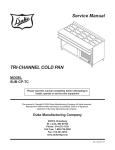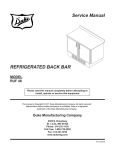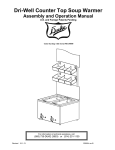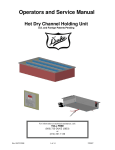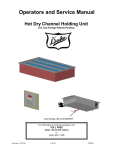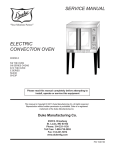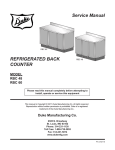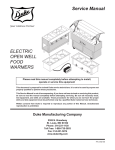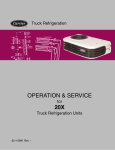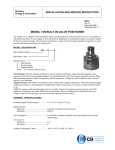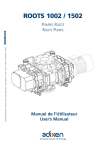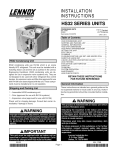Download Service Manual TRI-CHANNEL COLD PAN
Transcript
Service Manual TRI-CHANNEL COLD PAN MODEL SUB-cP Please read this manual completely before attempting to install, operate or service this equipment This manual is Copyright © 2005 Duke Manufacturing Company. All rights reserved. Reproduction without written permission is prohibited. Duke is a registered trademark of the Duke Manufacturing Company. Duke Manufacturing Company 2305 N. Broadway St. Louis, MO 63102 Phone: 314-231-1130 Toll Free: 1-800-735-3853 Fax: 314-231-5074 www.dukemfg.com P/N 219206A Service Manual for Tri-Channel Cold Pan SUB-GP IMPORTANT WARNING AND SAFETY INFORMATION WARNING Read this manual thoroughly before Operating, Installing, or performing Maintenance on the equipment. WARNING FAILURE TO FOLLOW INSTRUCTIONS IN THIS MANUAL CAN CAUSE PROPERTY DAMAGE, INJURY OR DEATH. WARNING DO NOT STORE OR USE GASOLINE OR OTHER FLAMMABLE VAPORS OR LIQUIDS IN THE VICINITY OF THIS OR ANY OTHER APPLIANCE. WARNING UNLESS ALL COVER AND ACCESS PANELS ARE IN PLACE AND PROPERLY SECURED, DO NOT OPERATE THIS EQUIPMENT. CAUTION Observe the following: • Minimum clearances must be maintained from all walls and combustible materials. • Keep the equipment area free and clear of combustible material. • Adequate clearance for air openings. • Operate equipment only on the type of electricity indicated on the specification plate. • Retain this manual for future reference. 2 Service Manual for Tri-Channel Cold Pan SUB-GP Contents specifications..................................................................................................................................... 4 INSTALLATION......................................................................................................................................... 4 Location............................................................................................................................................... 4 Inside Unit............................................................................................................................................ 4 Outside Unit......................................................................................................................................... 4 Leveling............................................................................................................................................... 4 Stabilizing............................................................................................................................................ 4 Electrical Connection........................................................................................................................... 4 MAINTENANCE........................................................................................................................................ 5 Stainless Steel Care and Cleaning...................................................................................................... 5 PREVENTIVE MAINTENANCE................................................................................................................. 6 Cleaning the Condenser Coil............................................................................................................... 6 PARTS REPLACEMENT........................................................................................................................... 7 Thermostat Replacement.................................................................................................................... 7 General................................................................................................................................................ 7 Evaporator........................................................................................................................................... 7 General................................................................................................................................................ 7 Refrigeration System Replacement..................................................................................................... 8 General................................................................................................................................................ 8 Recharging Refrigeration System........................................................................................................ 8 General................................................................................................................................................ 8 Tools.................................................................................................................................................... 8 Charging Procedure............................................................................................................................ 9 electrical.......................................................................................................................................... 10 Electrical Schematic.......................................................................................................................... 10 troubleshooting.............................................................................................................................11 3 Service Manual for Tri-Channel Cold Pan SUB-GP specifications MODEL DESCRIPTION SUB-GP Tri-Channel Cold Pan MODEL SUB-GP Outside Unit VOLTAGE AMPS 120 VAC (60Hz) 7.9 220 VAC (50Hz) 4.4 DESCRIPTIONHEIGHT Tri-Channel 36.00 In. Cold Pan WIDTH 30.00 In. PH. 1 1 LENGTH 48.00 In. 60.00 In. 74.00 In. 86.00 In. INSTALLATION Location The unit represented in this manual is intended for indoor use only. Be sure the chosen location has a floor strong enough to support the total weight of the unit. Reinforce the floor if necessary to provide for maximum loading. For the most efficient operation, be sure to provide good air circulation inside and out. The outline dimensional drawing for the unit is shown below in Figure 1. Be sure that the unit has access to ample air; avoid hot corners and locations near stoves and ovens. Leveling Be sure that the unit is placed on a firm, flat surface/floor. Check for cracks in flooring or tile and avoid these areas if possible. If necessary place support pads, properly rated for the weight of the unit, to “bridge” uneven or cracked flooring. Level unit accordingly. Stabilizing Use the leg adjustments to insure that the unit is solid to the floor surface at all four contact points. Insure that the unit does not “rock” when pressure is applied to the top corners. Electrical Connection The Tri-Channel Cold Pan is available as a 120VAC, 60 Hz or as a 220VAC, 50 Hz dependent on model. All electrical connections should be performed by a certified electrician and should comply with local electrical codes for your municipality. WARNING Figure 1 Tri-Channel Cold Pan Inside Unit Provide adequate space along the front and back taking care to not block airflow to the fan. REFER TO THE AMPERAGE DATA LIST IN THE SPECIFICATIONS OR THE SERIAL TAG DATA AND YOUR LOCAL CODE OR THE NATIONAL ELECTRICAL CODE TO BE SURE UNIT IS CONNECTED TO THE PROPER POWER SOURCE. A PROTECTED CIRCUIT OF THE CORRECT VOLTAGE AND AMPERAGE MUST BE RUN FOR CONNECTION OF THE SUPPLY CORD OR PERMANENT CONNECTION TO THE UNIT. THE POWER MUST BE TURNED OFF AND DISCONNECTED WHENEVER PERFORMING MAINTENANCE OR REPAIR FUNCTIONS. MAINTENANCE Stainless Steel Care and Cleaning 4 Service Manual for Tri-Channel Cold Pan SUB-GP Stainless steel contains 70-80% iron, which will rust. It also contains 12-30% chromium, which forms an invisible passive film over the steel surface and acts as a shield against corrosion. As long as the protective film remains intact, the metal will not corrode. However, if the film is broken or contaminated, outside elements can begin to breakdown the steel and begin to form rust or discoloration. To prevent rust and discoloration on stainless steel, several important steps need to be taken. CAUTION: Never use steel wool pads or wire brushes or scrapers. Avoid cleaning solutions that contain alkaline or chloride. Use alkaline based or non-chloride cleaning solutions. Anything containing chloride will damage the protective film on stainless steel. Chlorides are found in household and industrial cleaners and also in hard water and salts. If a chloride or alkaline cleaner has been used, rinse repeatedly and dry thoroughly. CAUTION: Never use an acid-based cleanser! Be sure to clean all food products from any stainless surface. Many food products contain acid, which can deteriorate the finish. Common foods include tomatoes, peppers and other vegetables. WARNING THE POWER MUST BE TURNED OFF AND DISCONNECTED AT ALL TIMES DURING MAINTENANCE OR REPAIR FUNCTIONS. PREVENTIVE MAINTENANCE Always use only soft cloths or plastic scouring pads. For routine cleaning, use warm soapy water. For stubborn stains use a non-abrasive cleanser. For heavy grease use a degreaser. For best results, rub with the grain of the steel. Pitting and cracking are early signs of stainless steel breakdown. But special stainless steel cleaners can restore and preserve the protective film. If signs of breakdown appear, thoroughly clean and dry all surfaces. Begin regular application of a high quality stainless steel cleaner according to the manufacturer’s instructions. Again, always rub with the grain of the steel for best results. 5 Service Manual for Tri-Channel Cold Pan SUB-GP �� �� ��� �� �� �� � �� �� �� � Figure 2 Location of Condensing Coil Cleaning the Condenser Coil Failure to maintain a clean condenser coil can initially cause high temperatures and excessive run times. Continuous operation with dirty or clogged condenser coils can result in compres- sor failure. Neglecting the condenser coil cleaning procedures will void all warranties and repair or replacement costs associated with the compressor. CAUTION: To clean the condenser, never use a high-pressure water wash, which can damage electrical components located at or near the condenser coil. 6 Figure 3 Location of Condensing Coil The condenser coil is located and accessed from the front of the unit, (Figure 3). A vent cover protects the condenser from damage. The condenser coil requires regular cleaning and should be done every 60 days. However, if large amounts of dust and grease accumulate sooner, clean the condenser coil every 30 days. For light dust, use a soft, non-wire brush. For heavier dust, use a vacuum or blow with compressed air. For heavy grease, use a degreasing agent made specifically for condenser coils on refrigeration units. Spray the degreasing agent on the coil and then blow with compressed air. Never wash with high-pressure water, which can damage the electrical components located at or near the condenser coil. Service Manual for Tri-Channel Cold Pan SUB-GP PARTS REPLACEMENT NOTE: Do not kink thermostat probe. Thermostat Replacement 9. Install thermostat probe in evaporator coil. 10.Using tags, connect thermostat wiring. 11.Install control panel cover and mounting screws. 12.Install condenser 13.Connect unit to power source and test refrigeration assembly. Evaporator Figure 4 Location of Thermostat General The thermostat is located in front on the control panel below the refrigeration assembly, (Figure 4). Figure 5 Location of Evaporator Coil 1. Disconnect unit from power source. 2. R e m o v e c o n t r o l p a n e l c o v e r w i t h thermostat. 3. Tag and disconnect thermostat wiring. 4. The evaporator coil is located above the refrigeration assembly. Remove thermostat probe from evaporator coil. General The evaporator coils are embedded in the upper body, (Figure 5) of the Tri-Channel Cold Pan. They cannot be serviced or replaced. The entire upper body must be replaced. 5. Remove knob. 6. Remove thermostat mounting screws. 7. Remove thermostat from control panel. 8. Install replacement thermostat, mounting screws and knob. 7 Service Manual for Tri-Channel Cold Pan SUB-GP Refrigeration System Replacement General assembly, pressure check evaporator coils for leaks. 9. Install replacement refrigeration assembly onto slide bars. 10.Slide in refrigeration assembly to original position. 11.Install refrigeration assembly mounting hardware. 12.Install expansion valve and evaporator tubing from refrigeration assembly. 13.Using tags, connect wiring at junction box. 14.Connect unit to power source and test unit. 15.ChargesystemaccordingtoDukeManufacturing Service Bulletin Number 26. 16.Install vent cover. Figure 6 Location of Refrigeration Assembly The refrigeration system assembly is located in the front of the unit, (Figure 6). 1. Disconnect unit from power source. 2. Remove vent cover. 3. Using a refrigeration-charging unit, evacuate refrigerant from the system according to Duke Manufacturing Service Bulletin Number 26. 4. Remove expansion valve and evaporator tubing from refrigeration assembly. Recharging Refrigeration System General To analyze the performance of a refrigeration system, temperature readings are recorded and converted to pressure readings using a standard pressure/temperature chart. When it is necessary to service a factory sealed refrigeration system and return it to its properly sealed condition, strictly adhere to the following approved procedure. 5. Remove refrigeration assembly mounting hardware. Tools • Standard hand and refrigeration tools 6. Tag and disconnect wiring at junction box. • Refrigerant Type: R-134A, 4.5 ounces 7. Slide out refrigeration assembly through vent. 8. Thoroughly clean the refrigeration assembly compartment. NOTE: Before installing replacement refrigeration 8 Charging Procedure Service Manual for Tri-Channel Cold Pan SUB-GP NOTE: Prior to refrigeration system service, special care must be taken during the evacuation process to remove air, moisture and other non-condensables from the system. Duke Manufacturing recommends the following triple evacuation method. Failure to follow this procedure may result in poor refrigeration system performance. 1. Evacuate system to 1500 microns. 2. Break vacuum to 2 psig with dry nitrogen. If dry nitrogen is unavailable, use same type of refrigerant as used in system. 3. Evacuate system to 500 microns. 4. Break vacuum to 2 psig with dry nitrogen. If dry nitrogen is unavailable, use same type of refrigerant as used in system. 5. Evacuate system to 500 microns. The system is now ready to receive refrigerant charge according to information on data plate. 2. Use temporary valves to perform repair. Duke Manufacturing will not reimburse the cost of permanently installed valves. 3. After completing repair, evacuate system using the triple evacuation method described in Duke Manufacturing Service Bulletin Number 26. 4. After completing proper evacuation method, recharge system, using proper refrigerant according to information on data plate. 5. Continue crimping process hose just below temporary valve and again 2” below crimp. 6. With crimp tool in place, remove temporary valve. 7. Braze shut end of process hose. 8. Allow to cool for about 5 minutes. 9. Remove crimp tool. 10.Check brazed end for leaks. CAUTION: Never use oxygen or acetylene in place of dry nitrogen or refrigerant for leak testing. A violent explosion may result, causing property damage, personal injury or death. When using nitrogen to pressure test, always use a pressure regulator. Failure to do so will result in extremely high pressure of the compressor or other system components and result in property damage, personal injury and death. NOTE: Prior to repair, ensure there is enough process hose (approximately 12”) present to complete the repair using the above procedure. If not, install a new process hose before repair sequence. 1. Install a temporary access valve on the high and low side of process hoses as close to factory crimps as possible. 9 Service Manual for Tri-Channel Cold Pan SUB-GP electrical Electrical Schematic Figure 7 Electrical Schematic 10 Service Manual for Tri-Channel Cold Pan SUB-GP troubleshooting SYMPTOM Cabinet too warm CAUSE Unit not plugged in Thermostat set too warm Thermostat switch stuck open in coldest position Doors not sealing Torn or damaged door gaskets Evaporator fan not running Condenser fan motor not running Dirty condenser coil or filter Refrigerant leak Thermostat set too cold Cabinet too cold Thermostat switch is stuck in the closed position Drain hose plugged Drain hose loose or disconnected from drain pan REMEDY Plug unit in Set thermostat to a higher number for a colder temperature Replace thermostat Adjust doors Replace gaskets Check and repair or replace motor Check and repair or replace motor Clean coil or filter Find leak, repair and recharge Set thermostat to a lower number for a warmer temperature Replace thermostat Clear drain hose Tighten or connect drain hose Water in bottom of unit 11 Duke Manufacturing Company 2305 N. Broadway St. Louis, MO 63102 Phone: 314-231-1130 Toll Free: 1-800-735-3853 Fax: 314-231-5074 www.dukemfg.com P/N 219206












